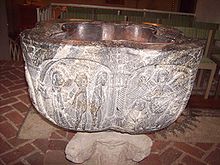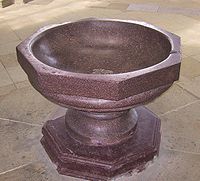Baptismal font: Difference between revisions
No edit summary |
|||
| Line 40: | Line 40: | ||
[[Category:Baptism]] |
[[Category:Baptism]] |
||
[[Category:Furniture]] |
[[Category:Furniture]] |
||
[[Category:Religious objects]] |
|||
[[ca:Pila baptismal]] |
[[ca:Pila baptismal]] |
||
Revision as of 16:51, 16 May 2009

A baptismal font is an article of church furniture or a fixture used for the baptism of children and adults.
Aspersion and affusion fonts

The fonts of many Christian denominations are intended for baptisms using a non-immersion method, such as aspersion or affusion. The simplest of these fonts has a pedestal (about 1.5 metres tall) with a holder for a basin of water. The materials vary greatly consisting of carved and sculpted marble, wood, or metal. The shape can vary. Many are 8-sided as a reminder of the "new creation" and as a connection to the practice of circumcision which traditionally occurs on the 8th day. Some are 3-sided as a reminder of the Holy Trinity Father, Son, and Holy Ghost.
Fonts are often placed at or near the entrance to a church's nave to remind believers of their baptism as they enter the church to worship, since the rite of baptism served as their initiation into the Church. In many churches of the Middle Ages and Renaissance there was a special chapel or even a separate building for housing the baptismal fonts, called baptistery.

The quantity of water is usually small (usually a litre or two). There are some fonts where water pumps, a natural spring, or gravity keeps the water moving to mimic the moving waters of a stream. This visual and audible image communicates a "living waters" aspect of baptism. Some church bodies use special "holy water" while others will use water straight out of the tap to fill the font. A special silver vessel called an Ewer can be used to fill the font.
The mode of a baptism at a font is usually one of sprinkling, pouring, washing, or dipping in keeping with the Koine Greek verb βαπτιζω. Βαπτιζω can also mean immerse, but most fonts are too small for that application. Some fonts are large enough to allow the immersion of infants, however.
Immersion fonts

The earliest baptismal fonts were designed for full immersion, and were often cross-shaped with steps (usually three, for the Trinity) leading down into them. Often such baptismal pools were located in a separate building, called a baptistery, near the entrance of the church. As infant baptism became more common, fonts became smaller. Denominations which believe only in baptism by full immersion tend to use the term "baptism font" to refer to immersion tanks dedicated for that purpose, however in the Roman Catholic tradition a baptismal font differs from an immersion.
Full-immersion baptisms may take place in a man-made tank or pool, or a natural body of water such as a river or lake. The entire body is fully immersed, dunked, submerged or otherwise placed completely under the water. This practice symbolizes the death of the old nature, as found in Romans 6:3–4.

In the Eastern Orthodox Church baptism is always by full triple immersion, even in the case of infant baptism (aspersion or pouring is permitted only in extremist). For this reason, Eastern baptismal fonts tend to be larger than Western, and are often shaped like a large chalice (significant, since the Orthodox administer Holy Communion to infants after baptism), and are normally fashioned out of metal rather than stone or wood. During the baptismal service, three candles will be lit on or around the baptismal font, in honor of the Holy Trinity. In many Orthodox churches, a very special kind of holy water, called "Theophany Water", is consecrated during the Feast of Theophany (Epiphany). The consecration (lit., "Great Blessing") is performed twice: the first time in a baptismal font, the second in a natural body of water.
In the Roman Catholic church, especially after its Second Vatican Council (1962-1965), greater attention is being given to the form of the baptismal font. Currently, the Roman Catholic church encourages baptismal fonts that are suitable for the full immersion of an infant or child, and for at least the pouring of water over the whole body of an adult. The font should be located in a space that is visibly and physically accessible, and should preferably make provision for flowing water.
Baptisms of The Church of Jesus Christ of Latter-day Saints are usually done in a simple font located in a local meetinghouse, although they can be performed in any body of water in which the person may be completely immersed. In Latter-day Saint temples, where proxy baptisms for the dead are performed, the fonts rest on the sculptures of twelve oxen representing the twelve tribes of Israel, following the pattern of the "molten sea" in the Temple of Solomon (see 2 Chronicles 4:2-5).
